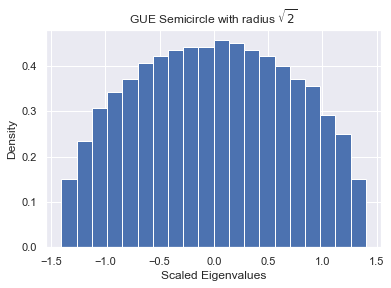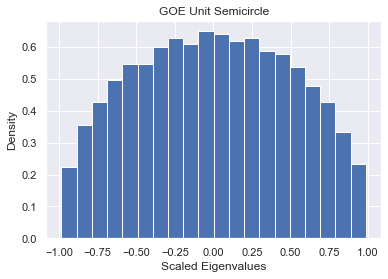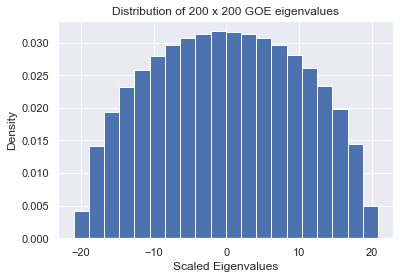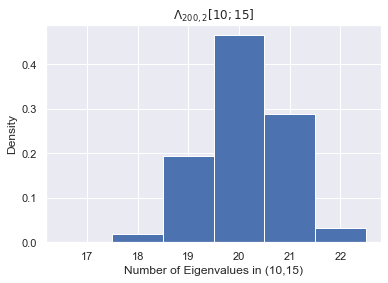import numpy as np
import matplotlib.pyplot as plt
from sympy import *
import seaborn as sns
import sys
sys.path.append('../')
import RandomMatrix as RM
%matplotlib inline
sns.set()
np.random.seed(140)
The semicircle distribution of radius $r > 0$ is supported on $[-r, r]$ with density
$$\sigma_r(x) = \frac{2}{\pi r^2} \sqrt{r^2 - x^2}$$If one plots the density, it becomes apparent why this is called the semicircle distribution.
Theorem Suppose $X$ has the semicircle distribution with radius $r$ and $\alpha > 0 \in \mathbb{R}$, then $\alpha X$ has the semicircle distribution with radius $\alpha r$.
Proof Suppose $f(x)$ is the density of $\alpha X$, then by the linear transformation for density formula;
$$f(x) = \frac{\sigma_r(\frac{x}{\alpha})}{\alpha} = \frac{2}{\pi r^2 \alpha} \sqrt{r^2 - \left(\frac{x}{\alpha} \right)^2} = \frac{2}{\pi (\alpha r)^2} \sqrt{(\alpha r)^2 - x^2}$$Thus $f = \sigma_{\alpha r}$
Suppose we are interested in the distribution of a single arbitrary (not necessarily the biggest or smallest) eigenvalue $\lambda_1$ of a Gaussian Ensemble with Dyson index $\beta$. If we let $f$ be the joint density of the eigenvalues (given in the introduction of the chapter) and $\rho$ be the density of $\lambda_1$, by conditioning on the other eigenvalues (which are not independent), we get
$$ \rho(\lambda_1) = \int_{-\infty}^{\infty} \cdot \cdot \cdot \int_{-\infty}^{\infty} f(\lambda_1, \lambda_2,... \lambda_N) \ d\lambda_2 \cdot \cdot \cdot d\lambda_N $$Wigner's Semicricle Law studies the distribution of $\lambda_1$ as $N \longrightarrow \infty$
Wigner's Semicircle Law:
$$\lim_{N \longrightarrow \infty} \sqrt{\beta N} \rho(\sqrt{\beta N}\lambda_1) = \sigma_{\sqrt{2}}(\lambda_1)$$Note this implies that $\frac{\lambda_1}{\sqrt{\beta N}}$ tends to a semicircle distribution with radius $\sqrt{2}$ as $N$ gets large.
N = 1000
GOE_λs, _ = np.linalg.eigh(RM.Generate_GOE(N))
GOE_scaled_eigenvalues = GOE_λs/(np.sqrt(N))
plt.ylabel("Density")
plt.xlabel("Scaled Eigenvalues")
plt.title("GOE Semicircle with radius $\sqrt{2}$")
plt.hist(GOE_scaled_eigenvalues, bins=20, density=True);
N = 1000
GUE_λs, _ = np.linalg.eigh(RM.Generate_GUE(N))
GUE_scaled_eigenvalues = GUE_λs/(np.sqrt(2*N))
plt.ylabel("Density")
plt.xlabel("Scaled Eigenvalues")
plt.title("GUE Semicircle with radius $\sqrt{2}$")
plt.hist(GUE_scaled_eigenvalues, bins=20, density=True);
We may use the scaling theorem to converge to different radii. If we want the eigenvalues to converge to a semicircle with radius $r$ we scale as follows
$$\frac{r \lambda_1}{\sqrt{2 \beta N}}$$Below we make the eigenvalues converge to the unit semicircle.
N = 1000
GOE_λs, _ = np.linalg.eigh(RM.Generate_GOE(N))
GOE_scaled_eigenvalues = GOE_λs/(np.sqrt(2*N))
plt.ylabel("Density")
plt.xlabel("Scaled Eigenvalues")
plt.title("GOE Unit Semicircle")
plt.hist(GOE_scaled_eigenvalues, bins=20, density=True);
N = 1000
GUE_λs, _ = np.linalg.eigh(RM.Generate_GUE(N))
GUE_scaled_eigenvalues = GUE_λs/np.sqrt(4*N)
plt.ylabel("Density")
plt.xlabel("Scaled Eigenvalues")
plt.title("GUE Unit Semicircle")
plt.hist(GUE_scaled_eigenvalues, bins=20, density=True);
Note that for a Gaussian Ensemble, $\frac{\lambda}{\sqrt{\beta N}}$ having the Semicircle($\sqrt{2}$) distribution implies $\lambda \sim $ Semicircle($\sqrt{2 \beta N}$). Below is a demonstration for $N=200$ and $\beta = 1$ and as expected we see a semicircle of radius 20.
trials = 1000
all_eigs = []
N = 200
for _ in range(trials):
A = RM.Generate_GOE(N)
λs, V = np.linalg.eigh(A)
all_eigs.extend(λs)
plt.ylabel("Density")
plt.xlabel("Scaled Eigenvalues")
plt.title("Distribution of 200 x 200 GOE eigenvalues")
plt.hist(all_eigs, bins=20, density=True);
Let $\Lambda_{N, \beta}[a;b]$ be the number of eigenvalues in the interval $[a,b]$ of an $N \times N$ Gaussian ensemble with Dyson index $\beta$. Then
$$ \lim_{N \rightarrow \infty} \Lambda_{N, \beta}[a;b] \overset{p}{\to} N \int_a^b \sigma_{\sqrt{2 \beta N}}(t) \ dt$$where $\overset{p}{\to}$ denotes convergence in probability. We can find a closed form expression for the integral using SymPy
t = symbols("t")
N, β = symbols("N β", positive=True)
σ = 2/(pi*(2*β*N)) * sqrt((2*β*N) - t**2)
Λ_N_β = integrate(N*σ, t)
Λ_N_β
Note that Sympy denote $\sin^{-1}$ as asin. Let's approximate $\Lambda_{200, 1}[10;15]$.
Λ_200_1 = Λ_N_β.subs(N, 200).subs(β, 1)
Λ_200_1
(Λ_200_1.subs(t, 15) - Λ_200_1.subs(t, 10)).evalf()
Let's check this approximation empirically
trials = 1000
in_range = []
matrix_size = 200
for _ in range(trials):
A = RM.Generate_GOE(matrix_size)
λs, V = np.linalg.eigh(A)
in_range.append(sum((10 < λs) & (λs < 15)))
plt.ylabel("Density")
plt.xlabel("Number of Eigenvalues in (10,15)")
plt.title("$\Lambda_{200, 1}[10;15]$")
plt.hist(in_range, bins=np.array(list(set(in_range)))-0.5, density=True);
np.mean(in_range)
As we can see, $\Lambda_{N,1}[10;15]$ successfully predicts the number eigenvalues in $(10,15)$ with reasonable variance. We can likewise predict $\Lambda_{200, 2}[10;15]$
Λ_200_2 = Λ_N_β.subs(N, 200).subs(β, 2)
Λ_200_2
(Λ_200_2.subs(t, 15) - Λ_200_2.subs(t, 10)).evalf()
trials = 1000
in_range = []
N = 200
for _ in range(trials):
A = RM.Generate_GUE(N)
λs, V = np.linalg.eigh(A)
in_range.append(sum((10 < λs) & (λs < 15)))
plt.ylabel("Density")
plt.xlabel("Number of Eigenvalues in (10,15)")
plt.title("$\Lambda_{200, 2}[10;15]$")
plt.hist(in_range, bins=np.array(list(set(in_range)))-0.5, density=True);
np.mean(in_range)







